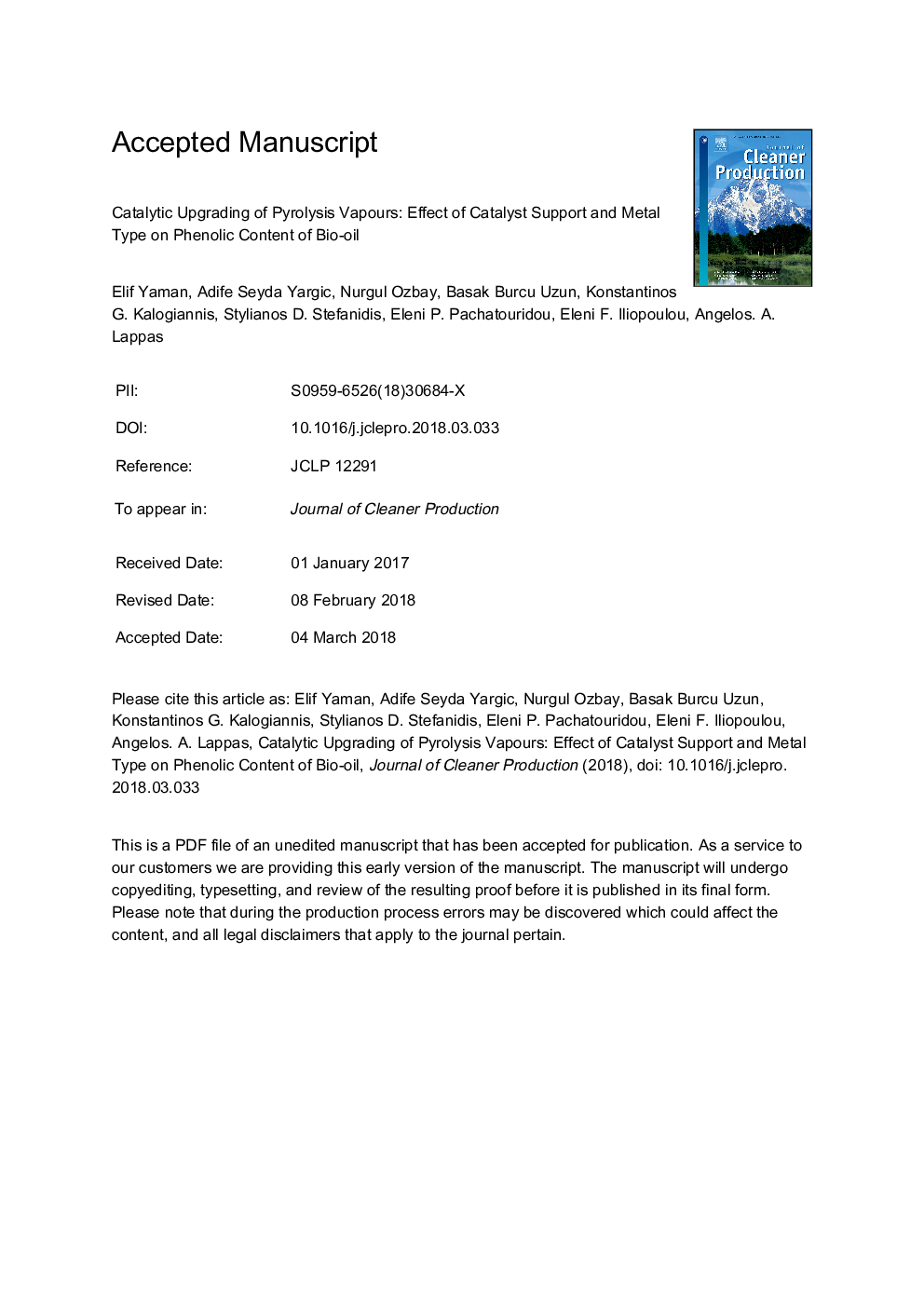| کد مقاله | کد نشریه | سال انتشار | مقاله انگلیسی | نسخه تمام متن |
|---|---|---|---|---|
| 8096374 | 1522068 | 2018 | 42 صفحه PDF | دانلود رایگان |
عنوان انگلیسی مقاله ISI
Catalytic upgrading of pyrolysis vapours: Effect of catalyst support and metal type on phenolic content of bio-oil
ترجمه فارسی عنوان
ارتقاء کاتالیزوری بخار های پیلوریلیز: تأثیر حمایت کاتالیست و نوع فلز بر میزان فنلی روغن زیستی
دانلود مقاله + سفارش ترجمه
دانلود مقاله ISI انگلیسی
رایگان برای ایرانیان
کلمات کلیدی
پیش درمان اسید، روغن زیتون، پیرولیز کاتالیستی، نوع کاتالیست محتویات فنلی، پوست گردو،
موضوعات مرتبط
مهندسی و علوم پایه
مهندسی انرژی
انرژی های تجدید پذیر، توسعه پایدار و محیط زیست
چکیده انگلیسی
Bio-oil from low-cost and renewable lignocellulosic biomass is a complex mixture of organic compounds and water. It is necessary to selectively control the biomass pyrolysis pathways to obtain specific bio-oils rich in value-added chemicals. Microporous and mesoporous catalysts can be good candidates for the catalytic pyrolysis of biomass leading to the production of valuable components such as aromatic hydrocarbons and phenolics. In this study, in-situ catalytic upgrading of pyrolysis vapours from acid pre-treated walnut shell was carried out in a lab scale fixed bed reactor with microporous nickel or cobalt impregnated Zeolite Socony Mobil-5 and mesoporous aluminum or iron impregnated Santa Barbara Amorf-15 catalysts. The effects of catalyst modification on product yields, bio-oil quality and the variation of the phenolic compounds in pyrolytic-oil were examined using elemental analysis, gas chromatography and mass spectrometry. The major improvement in the bio-oil quality by the catalyst addition was the reduction of the oxygen content of the bio-oil's organic fraction and the increase in valuable chemicals (aromatics and phenolics), while the total liquid yield (bio-oil) decreased. Catalysts also increased the gaseous product yields. In comparison to non-catalytic experiments, all the Proton-exchanged Zeolite Socony Mobil-5 catalysts decreased both the total liquid and the total organic content yield due to the H+-form zeolite catalysing hydrocarbon conversion reactions. Compared to Proton-exchanged Zeolite Socony Mobil-5, the metal impregnated catalysts yielded less water, but favoured the formation of gas products. It was evident that impregnation with metals changed the mechanism of oxygen removal. Cobalt/Proton-exchanged Zeolite Socony Mobil-5 favoured the formation of carbon dioxide over carbon monoxide, while nickel/Proton-exchanged Zeolite Socony Mobil-5 favoured the formation of carbon monoxide over carbon dioxide. When using Proton-exchanged Zeolite Socony Mobil-5 instead of silica sand, the guaicols and syringol that are formed from the thermal decomposition of the lignin fraction in the sulphuric acid treated walnut shell are significantly reduced and are mainly converted to alkylated phenols and aromatic and polyaromatic hydrocarbons. With the impregnation of metals on the Santa Barbara Amorf-15, the selectivity of the Santa Barbara Amorf-15 exhibited a shift from catechol- and pyrogallols-type compounds to alkylated phenols, especially at 10% aluminum, 30% and 50% iron metal loadings. As a result, the bio-oil composition and quality can be improved by utilizing different metals and metal impregnation ratios during catalytic upgrading. According to the preliminary economic analysis, pyrolysis oil production cost predicted from catalytic pyrolysis of walnut shell is higher than catalytic pyrolysis of woody biomass because of lower pyrolysis oil yield of walnut shell.
ناشر
Database: Elsevier - ScienceDirect (ساینس دایرکت)
Journal: Journal of Cleaner Production - Volume 185, 1 June 2018, Pages 52-61
Journal: Journal of Cleaner Production - Volume 185, 1 June 2018, Pages 52-61
نویسندگان
Elif Yaman, Adife Seyda Yargic, Nurgul Ozbay, Basak Burcu Uzun, Konstantinos G. Kalogiannis, Stylianos D. Stefanidis, Eleni P. Pachatouridou, Eleni F. Iliopoulou, Angelos A. Lappas,
